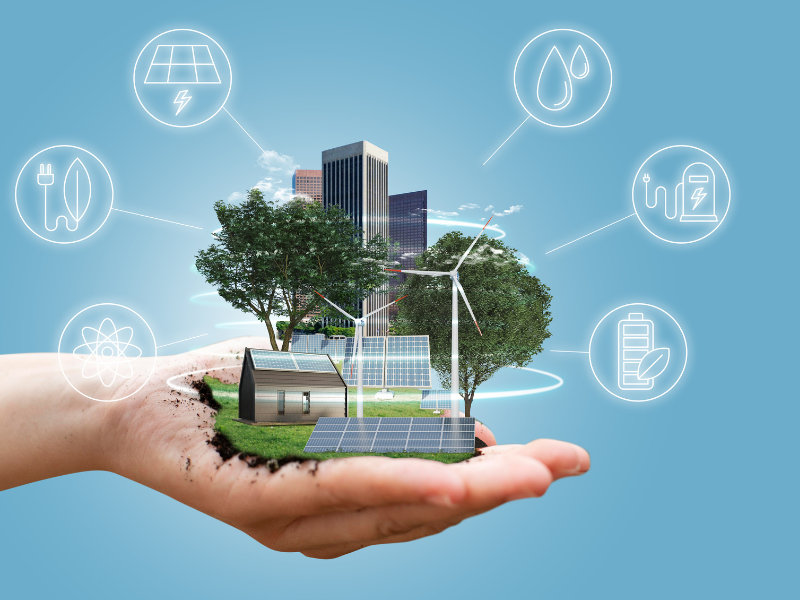In an era marked by rapid technological advancements and a growing global emphasis on sustainable practices, Britain stands at the forefront of a transformative shift in its energy economy. The country is not only reevaluating its energy mix but is also exploring innovative ways to meet its increasing energy demands while reducing its environmental footprint. Renewable energy has emerged as a key player in the UK’s energy landscape, offering a sustainable and environmentally friendly alternative to traditional fossil fuels.
In recent years, the country has made significant progress in harnessing renewable energy sources such as wind power, plant biomass, and solar power. As per reports, in 2019, the UK Climate Change Act set 2050 as the target to achieve net zero emissions. In 2022, the energy industry invested 17 billion dollor which was 7 percent of the overall investment in the country. The government came up with clean energy plans to target nuclear, offshore wind, and hydrogen power, among other initiatives including increasing energy efficiency, electric vehicle infrastructure, and carbon capture, utilization, and storage (CCUS).

Renewable Energy Revolution:
One of the most significant developments in Britain’s energy sector is the accelerating shift towards renewable energy sources. According to recent data from the National Grid, renewable energy accounted for more than 40% of the country’s electricity generation in the past year. This surge can be attributed to the increased capacity of wind and solar power installations.
Britain boasts some of the world’s largest offshore wind farms, harnessing the power of the North Sea. The Hornsea Wind Farm, for instance, is a monumental project contributing significantly to the national energy grid. The United Kingdom’s offshore wind capacity is expected to triple by 2030, according to projections by the Wind Energy Association. Solar power, another key player in the renewable energy sector, is witnessing a surge in installations across the country. The falling costs of solar panels and advancements in technology have made solar energy an economically viable option. The government’s initiatives to promote residential and commercial solar installations have further fueled this growth.
Targets and Policies for Renewable Energy in the UK
The UK government has been promoting the fair use of renewable energy alternatives to mitigate the impact of fossil fuel depletion. To help them reach the 2050 net zero target, the UK government has implemented various measures and introduced several laws.
The concept of achieving net-zero emissions means balancing the amount of greenhouse gases emitted with an equivalent amount removed from the atmosphere. This requires a comprehensive overhaul of the energy sector, including a shift away from fossil fuels towards renewable and low-carbon alternatives. To achieve this goal, the UK government has implemented various policies and initiatives aimed at decarbonising its energy system.

The government announced its Net Zero Strategy: Build Back Greener (Net Zero Strategy) in October 2021, outlining how it plans to accomplish the 2050 net-zero aim. One of the primary ways the UK wants to accomplish this is to increase the use of renewable energy and to make the biggest polluters pay the most for the transition through fair carbon pricing.
These include increasing renewable energy generation capacity, promoting energy efficiency measures, electrifying transportation, and supporting research and development in green technologies. Renewable energy sources such as wind, hydroelectric, solar, biomass, etc. are playing a significant role in meeting the demands of Britain’s energy needs while reducing carbon emissions. The UK has seen significant growth in offshore wind farms, which have become a major contributor to its renewable energy capacity.
The Growth of Renewable Electricity Generation
Over the past two decades, the UK has witnessed remarkable growth in renewable electricity generation. In the year 2000, renewables accounted for a mere 2.8% of the country’s total electricity generation. However, by 2022, this figure had skyrocketed to a record-breaking 40%. This increase of 5% from the previous year can be attributed primarily to the surge in wind power generation, driven by high wind speeds and the expansion of offshore capacity.
According to one estimate, renewable energy contributed to 41.5% of UK electricity generation the previous year(2022), while fossil fuels produced 40.8%. This expansion can be attributed to favorable weather conditions as well as the strong output from wind and solar energy. Wind continues to be the most important source of green and sustainable power in the United Kingdom, accounting for 24.7% of the country’s electricity. According to a report in 2022, solar photovoltaic cells have also considerably contributed to power production, reaching 13,283 GWH, a stunning increase from the statistics in 2004, when it was only 4 GWH.

The Economic Impact and Opportunities
UK government is actively working towards achieving net-zero emissions as part of its commitment to combat climate change. By embracing renewable energy sources and promoting energy efficiency measures across sectors, the UK aims to lead by example in building a sustainable future while reaping economic benefits along the way. This includes developing new clean energy-producing methods, including hydrogen fuel cells, and improving battery storage systems for sporadic renewable energy sources. The UK is accelerating its efforts to exploit renewable energy sources, such as wind, solar, hydro, and nuclear power, while also investing in new technologies like carbon capture and storage.. The UK is transitioning to a low-carbon economy gradually by not only mitigating the risks associated with fossil fuel dependency, but also aligning with global climate commitments and ensuring a sustainable future for generations to come.





















